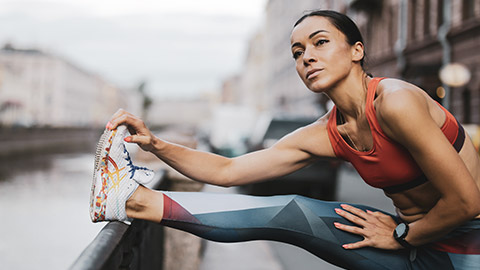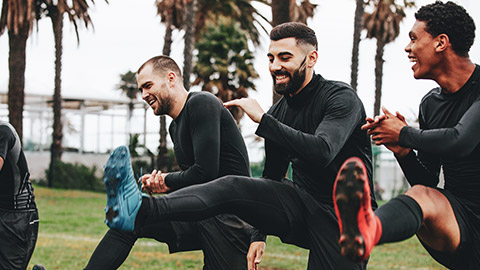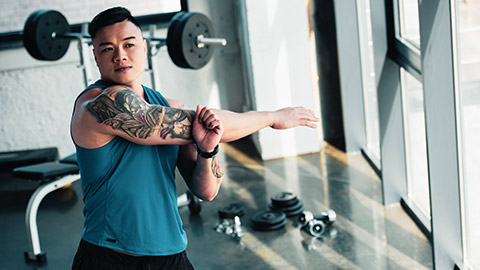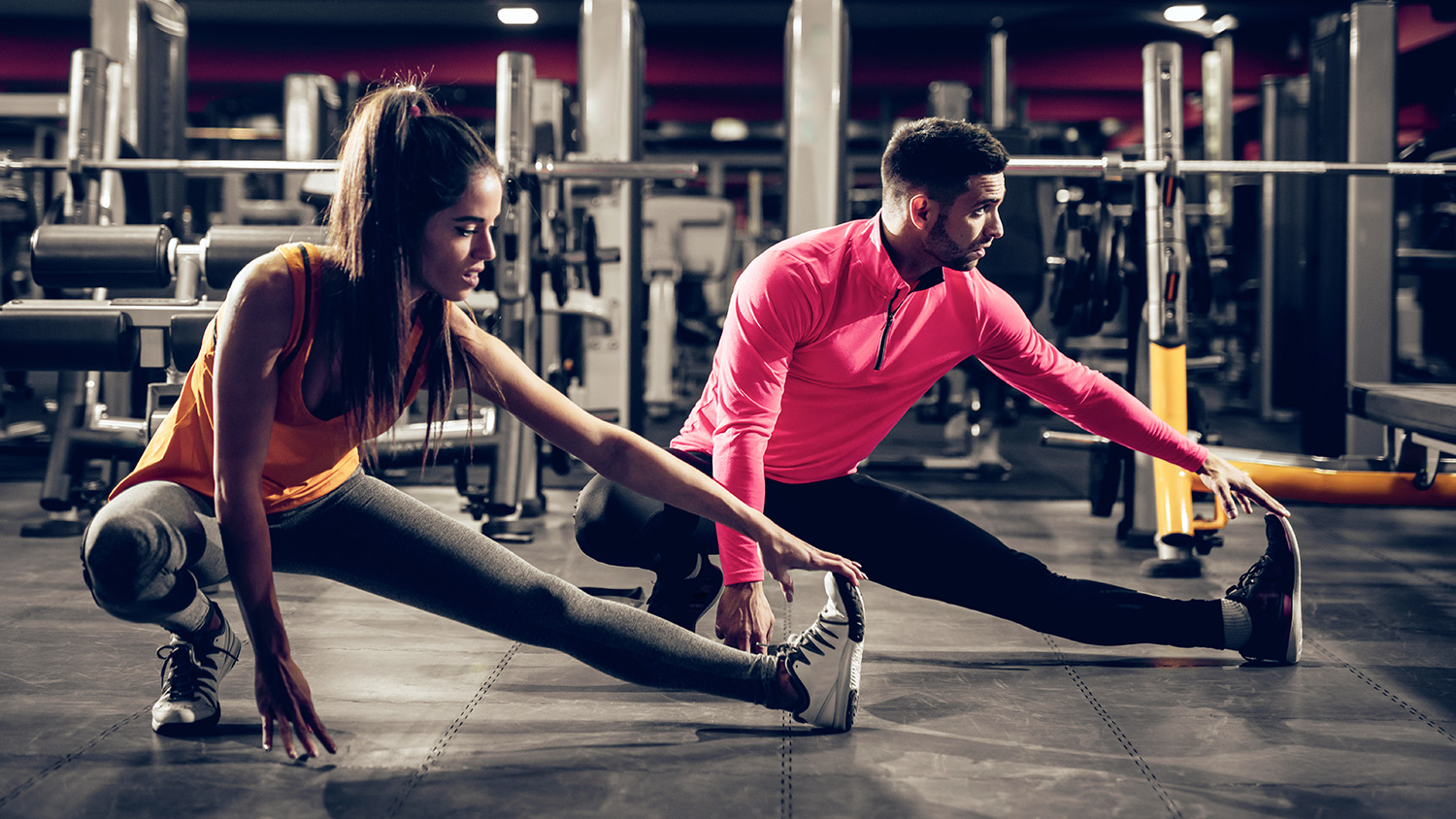Stretching activities are part of both a warm-up and a cool-down. They can also form the main activity such as in yoga style class. Stretches improve your health, muscle tone, and flexibility. Stretching is an important part of exercise, enhancing overall performance and preventing injuries during activity.
There are 2 main types of stretches: static stretches and dynamic stretches. We've covered stretches previously so before jumping into the specifics of each type of stretch, let's see what you can recall.

Static and dynamic stretches have different functions. Static (or passive) stretches lengthen a muscle and you're holding that stretch for at least 25 to 30 seconds. An easy way to think about this is whatever muscle you're trying to stretch, identify the origin and the insertion of that muscle. You are getting the origin and insertion as far away from each other comfortably without compromising the movement of the joint. That's a stretch.
The reason we say 25 to 30 seconds is because the fun thing with static stretching is it involves what we call the GTO or the Golgi Tendon Organ. It lies between the muscle and its tendon area, and its primary role is to recognise the force being pulled on in that muscle. When it recognises a force, it sends a signal back up to the brain, which then sends signals back to the muscle and tells those myosin and actin fibres to relax and lengthen, creating a feedback loop. The receiver feels the stress, sends something up to the brain, and the brain tells that muscle to relax.

Dynamic stretching is when we create a movement for the muscle we're trying to stretch. For example, an active (or dynamic) hamstring stretch would be like a swooping crane motion.
Think about a starting blocks position for a running race. To dynamically stretch, the runner will push their hips up to the top and then come back down, and repeat. Active stretches are about taking the muscle to the range of its motion. It's a really good preparatory way of stretching because you don't want the first time your muscle hits its end range of motion to be under load or intensity. Dynamic stretching will also stimulate light synovial fluid in the joint, acting as a lubricant. For these reasons, dynamic stretching is predominately used in warm-ups.
In this topic, you will learn:
- The importance of stretching
- Common stretches
Davy and Mya will demonstrate how to perform and instruct the following stretches:
- Biceps and forearms
- Calf
- Child's pose
- Cobra
- Deltoid
- Downward dog
- Forward fall
- Garland
- Glute
- Hamstrings
- Hip flexor
- Lat cat cow
- Middle and upper trap
- Pec
- Quadriceps
- Side bridge
- Triceps
- Upper back
- Wrist fall up and down

It's not enough to build muscle and achieve aerobic fitness. You need to think about flexibility, too. Stretching can help.
It is not only runners, gymnasts, or elite athletes who need to warm up and stretch! Everyone in the general population needs to stretch and no fitness routine is complete without stretching exercises. Stretching should be integrated before, during, and after training sessions.
Previously, the school of thought was that stretching impaired those who wished to 'bulk up', and that stretching 'un-did' all the good work achieved in the gym. All those hours of lifting weights and shortening the muscles through resistance training, why stretch and undo this? Old school thinking!
Quite simply, there are many components to exercise. And many different components to a healthy, effective, and sustainable training regime and this means more than just lifting weights. Focusing on muscle building is not sufficient as we know; cardio is required for a more overall workout. This also applies to stretching which is just as important a fitness component as muscle building or cardio training.
What is stretching?
When strength training (or really, training in general) the exercise works the muscles by putting them under tension. As a result, the muscles become shorter and tenser, less flexible. This then has a knock-on effect on the tendons which attach the muscles to bone and the ligaments around a joint. With these components becoming tight and more rigid, this decreases the range of movement provided by that joint. It also results in less function capacity and can impair movement patterns leading to injury.
Stretching is a technique that is vital to maintaining homeostasis. This balance relates to the muscular system (and its connective tissue components), and the skeletal system and helps support their optimal function.
So, why is stretching so important?
Stretching techniques, performed when muscles are cold does not increase flexibility and may also lead to or result in injury. Tissue stretches best when smooth, slow force is applied due to its composition. Effective stretching occurs in a gentle and controlled manner, with muscles being of a warmer temperature (that is, not when the muscles are cold). This can be achieved by applying a heat pack or via ultrasound therapy. However, five to 10 minutes of muscular contraction (such as jogging, aerobics, gentle swimming session, or walking) is effective and typically safer. Why is that? Exercise heats the muscles more thoroughly, therefore, decreasing the risk of injury via surface level warmth only.
This is an example of why a warm-up and a cool-down are important parts of any exercise routine. Without an effective warm-up (or any warm-up at all for that matter) your training session is potentially off to a rocky start, which could impact your training regime should you become injured as a result.
We also need to stretch to:
- protect mobility and independence.
- keep the muscles flexible, strong, and healthy.
- maintain motion in the joints.
- increase blood flow and reduce stiffness.
- prevent injuries to the muscles which can lead to joint injuries.
Watch
Watch the benefits of stretching from the Mayo Clinic which will expand on the importance of stretching.
Depending on your exercise objectives and client requirements, you may use a combination of the following stretches. As you look at each, ask yourself if the stretch is static or dynamic, and when you might suggest it to a client.
Becoming comfortable with stretching is essential and will take a few forms (as exists with exercises) as you will need to become comfortable with:
- your dialogue when explaining to your client verbally how to perform each stretch safely and effectively.
- how to adapt your instructional terms should your client be unable to understand what you mean.
- being able to identify when an adaptation of the stretch is required.
- being able to clearly explain, in terms your client can understand, why they are performing a particular stretch (humans need context).
- adapt your planned stretching routine for your client should they present with either pain or discomfort.
It is just as important to be comfortable with your knowledge of stretches as with the individual exercises, take time to practice this, and lock in your knowledge. Consider practising in front of your mirror, with friends or family and fine-tune your verbal delivery should you identify areas of your instructions that are not clear enough for the stretch to be performed effectively and safely.
In this video series, Mya and Davy demonstrate stretches, including variations. Watch the videos and practice demonstrating and explaining the stretches.
Bicep and forearms
Calf stretch
Child's pose
Cobra
Deltoids
Downward dog
Forward fall
Garland
Glute
Hamstrings
Hip flexor
Lat cat cow
Middle and upper trap
Pec stretch
Quadriceps
Side bridge
Triceps
Upper back
Wrist fall up and down
Perform each stretch, including progressions and regressions where possible. Talk through the cues and what muscles are being targeted. Consider how each stretch supports health and skill-based fitness components and training principles.
Complete the self-assessment on demonstrating stretches. If you would like feedback, post in the forum.
Complete the self-assessment on explaining stretches. If you would like feedback, post in the forum.
